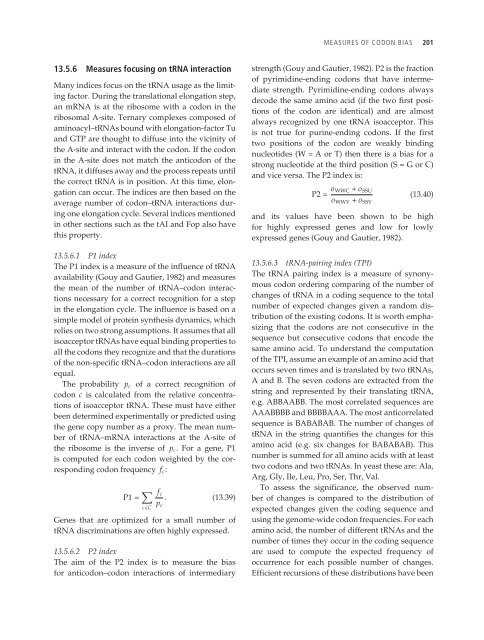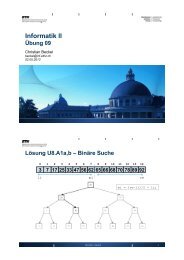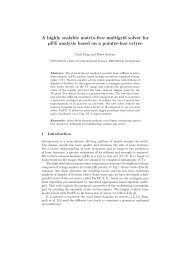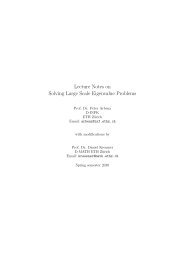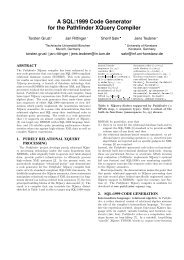Codon Evolution Mechanisms and Models
Codon Evolution Mechanisms and Models
Codon Evolution Mechanisms and Models
You also want an ePaper? Increase the reach of your titles
YUMPU automatically turns print PDFs into web optimized ePapers that Google loves.
13.5.6 Measures focusing on tRNA interaction<br />
Many indices focus on the tRNA usage as the limiting<br />
factor. During the translational elongation step,<br />
an mRNA is at the ribosome with a codon in the<br />
ribosomal A-site. Ternary complexes composed of<br />
aminoacyl–tRNAs bound with elongation-factor Tu<br />
<strong>and</strong> GTP are thought to diffuse into the vicinity of<br />
the A-site <strong>and</strong> interact with the codon. If the codon<br />
in the A-site does not match the anticodon of the<br />
tRNA, it diffuses away <strong>and</strong> the process repeats until<br />
the correct tRNA is in position. At this time, elongation<br />
can occur. The indices are then based on the<br />
average number of codon–tRNA interactions during<br />
one elongation cycle. Several indices mentioned<br />
in other sections such as the tAI <strong>and</strong> Fop also have<br />
this property.<br />
13.5.6.1 P1 index<br />
The P1 index is a measure of the influence of tRNA<br />
availability (Gouy <strong>and</strong> Gautier, 1982) <strong>and</strong> measures<br />
the mean of the number of tRNA–codon interactions<br />
necessary for a correct recognition for a step<br />
in the elongation cycle. The influence is based on a<br />
simple model of protein synthesis dynamics, which<br />
relies on two strong assumptions. It assumes that all<br />
isoacceptor tRNAs have equal binding properties to<br />
all the codons they recognize <strong>and</strong> that the durations<br />
of the non-specific tRNA–codon interactions are all<br />
equal.<br />
The probability pc of a correct recognition of<br />
codon c is calculated from the relative concentrations<br />
of isoacceptor tRNA. These must have either<br />
been determined experimentally or predicted using<br />
the gene copy number as a proxy. The mean number<br />
of tRNA–mRNA interactions at the A-site of<br />
the ribosome is the inverse of pc. Foragene,P1<br />
is computed for each codon weighted by the corresponding<br />
codon frequency fc:<br />
P1 = �<br />
c∈C<br />
fc<br />
pc<br />
. (13.39)<br />
Genes that are optimized for a small number of<br />
tRNA discriminations are often highly expressed.<br />
13.5.6.2 P2 index<br />
The aim of the P2 index is to measure the bias<br />
for anticodon–codon interactions of intermediary<br />
MEASURES OF CODON BIAS 201<br />
strength (Gouy <strong>and</strong> Gautier, 1982). P2 is the fraction<br />
of pyrimidine-ending codons that have intermediate<br />
strength. Pyrimidine-ending codons always<br />
decode the same amino acid (if the two first positions<br />
of the codon are identical) <strong>and</strong> are almost<br />
always recognized by one tRNA isoacceptor. This<br />
is not true for purine-ending codons. If the first<br />
two positions of the codon are weakly binding<br />
nucleotides (W = A or T) then there is a bias for a<br />
strong nucleotide at the third position (S = G or C)<br />
<strong>and</strong> vice versa. The P2 index is:<br />
P2 = oWWC + oSSU<br />
oWWY + oSSY<br />
(13.40)<br />
<strong>and</strong> its values have been shown to be high<br />
for highly expressed genes <strong>and</strong> low for lowly<br />
expressed genes (Gouy <strong>and</strong> Gautier, 1982).<br />
13.5.6.3 tRNA-pairing index (TPI)<br />
The tRNA pairing index is a measure of synonymous<br />
codon ordering comparing of the number of<br />
changes of tRNA in a coding sequence to the total<br />
number of expected changes given a r<strong>and</strong>om distribution<br />
of the existing codons. It is worth emphasizing<br />
that the codons are not consecutive in the<br />
sequence but consecutive codons that encode the<br />
same amino acid. To underst<strong>and</strong> the computation<br />
of the TPI, assume an example of an amino acid that<br />
occurs seven times <strong>and</strong> is translated by two tRNAs,<br />
A <strong>and</strong> B. The seven codons are extracted from the<br />
string <strong>and</strong> represented by their translating tRNA,<br />
e.g. ABBAABB. The most correlated sequences are<br />
AAABBBB <strong>and</strong> BBBBAAA. The most anticorrelated<br />
sequence is BABABAB. The number of changes of<br />
tRNA in the string quantifies the changes for this<br />
amino acid (e.g. six changes for BABABAB). This<br />
number is summed for all amino acids with at least<br />
two codons <strong>and</strong> two tRNAs. In yeast these are: Ala,<br />
Arg, Gly, Ile, Leu, Pro, Ser, Thr, Val.<br />
To assess the significance, the observed number<br />
of changes is compared to the distribution of<br />
expected changes given the coding sequence <strong>and</strong><br />
using the genome-wide codon frequencies. For each<br />
amino acid, the number of different tRNAs <strong>and</strong> the<br />
number of times they occur in the coding sequence<br />
are used to compute the expected frequency of<br />
occurrence for each possible number of changes.<br />
Efficient recursions of these distributions have been


